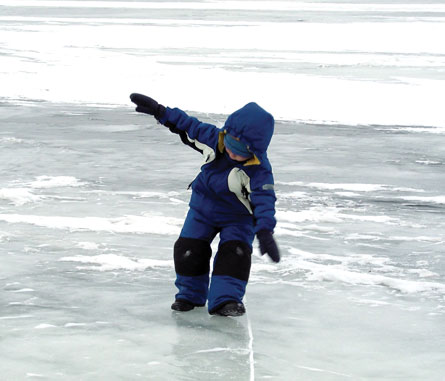Module 3—Effects of Force on Velocity
Lesson 2—Newton’s Third Law
 Get Focused
Get Focused

© Wendy Nero/shutterstock
One of the oldest ways of moving around is walking. Usually it’s easy, but ice can quickly change that.
Your first experience with walking on ice likely taught you two things. First, it is very slippery; and second, it is hard—especially for an uncontrolled landing! A question you likely didn’t ask while lying on the ice was “why?” Why is the ice so slippery? What does it mean to be slippery?
friction: the resistance to motion between two surfaces in contact
The answer to these questions is related to friction. Friction between your shoes and the ground provides traction to maintain your balance and enables you to move. Since ice is a nearly frictionless surface, you can quickly lose your ability to maintain balance and move while standing on it.
Imagine that the ice that the boy in the photo is standing on was “perfectly” frictionless. Would he be able to move or even stand up? Now, imagine that he had a physics textbook with him and had studied Newton’s three laws of motion. How could he use the book to get to the shore if no friction was present?
As you work through this lesson, keep these important questions in mind:
- How do Newton’s laws help explain why motion occurs?
- How do you find a reaction force?
- How does friction affect moving objects?
 Module 3: Lesson 2 Assignments
Module 3: Lesson 2 Assignments
Your teacher-marked Module 3: Lesson 2 Assignment requires you to submit a response to the following:
- Lab—LAB 1, LAB 2, LAB 3, and LAB 4
- Try This—TR 2, TR 3, TR 4, TR 5, and TR 6
- Discuss—D 1 and D 2
You must decide what to do with the questions that are not marked by the teacher.
Remember that these questions provide you with the practice and feedback that you need to successfully complete this course. You should respond to all the questions and place those answers in your course folder.
 Watch and Listen
Watch and Listen
Watch the video titled Newton’s Laws Part 3, which introduces you to Newton’s third law.